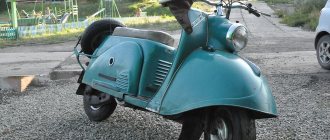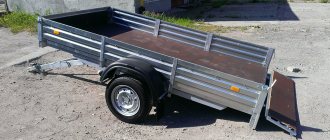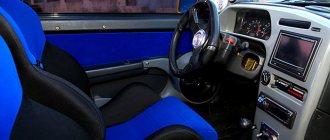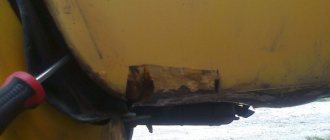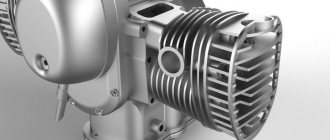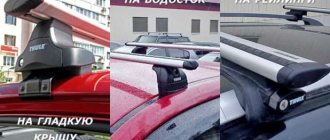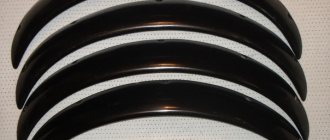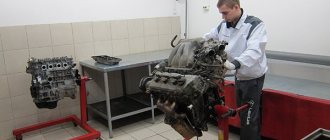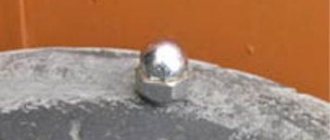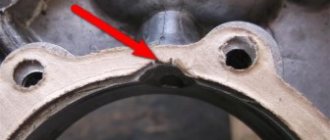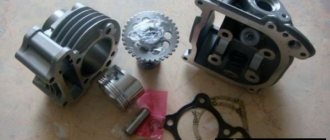Bright, stylish, but still Dnepr
Looking at this motorcycle, different emotions immediately appear in me. On the one hand, the author of the project had a hand and spent a lot of time creating this “horse”, but on the other hand, I don’t see much point in them. It is unlikely that this homemade seat will be more comfortable than the standard one.
Exhaust
- the highlight of the whole design. As for me, the “cans” are too massive for the pipes that go directly to the cylinders. I think if they were made thicker in cross-section, this modification would look somewhat more impressive.
The colors here are extremely bright and dull
, but this is
a matter of taste
. And, according to the classics of the genre, we are witnessing the abandonment of the steering wheel and the fact that the author of the project gave preference to clip-ons, completely cutting down the ability to move around on this motorcycle.
Java engine tuning
First of all, I would like to talk about modernizing the engine of this once legendary bike. The latter is done quite easily and quickly these days. The method of strengthening the power unit, given to us by our parents, will remain virtually unchanged. These motorcycles are quite easy to boost.
Tuning Java often involves adding another carburetor to the engine. In this case, the mounting of the basic fuel regulator is subject to change. A carburetor is installed on each cylinder only after a new mount (adapter) is installed on each “pot”. All this is mounted on pins - there is no need to invent anything new, as you can see for yourself. Each carburetor needs a separate filter. Buying a faucet for a tank with a couple of outlets is also not difficult.
Firstly, you need to adjust the purge channels for tuning the Java 350. In addition, the main goal of upgrading the Java engine is to increase the compression ratio. This way you can certainly supplement the power of the bike. All this won't cost that much. If you do not have the necessary tools and equipment for speeding up, you can turn to a turner. Even in small towns, such specialists are present, for which we must thank, first of all, the Soviet government, which relied on the engineering and mechanical potential of the labor resources of the USSR. There are many machines left on post-Soviet soil that are quite suitable for reducing the combustion chamber.
Do not forget that any changes to the combustion chamber, as well as the cylinder windows, must be carried out with the utmost care. Any mistake, in this case, can render the rather fragile duralumin “pots” unusable once and for all.
You will probably find photos of bikes after some of the above modifications here too.
Engine tuning Java 350
The first thing the owners of the “old lady” strive for is improving its speed performance. A common misconception in this regard is the need to equip a motorcycle with a 5-speed gearbox . Its installation can be partially justified only if the chassis and engine are modernized. Boosting the engine is a guaranteed increase in maximum speed and acceleration, but there are a couple of nuances here. Firstly, boring the cylinders leads to a decrease in the thickness of their walls, and, consequently, to an increase in heat transfer, which entails a loss of compression and possible jamming.
Secondly, forcing implies the combustion of more fuel in one cycle, which means increased fuel consumption and thermal stress of parts.
Therefore, in the case of boring, water or intensive forced cooling should be installed on the jackets and cylinder heads. It is also necessary to replace or reconfigure the carburetor to suit the increased “appetite” of the engine. Installing an electronic ignition from a VAZ 2106 will make the engine more playful, reduce vibration and reduce fuel consumption.
General concepts of Java tuning
Improving Czechoslovakian Jawa quite often involves the installation of new electronics. In addition to the ignition system, the number of lighting devices also changes. Fog lights are installed, new indicator lights are installed on the panel, the sound signal is replaced, etc. However, the instrument panel is often left unchanged by tuning specialists for the 634 Java. This legendary Czech motorcycle already has everything that is needed to indicate the operation of the bike. The most pleasing thing is the presence of a tachometer.
Sometimes the front end of the above iron horse becomes heavier. Since a motorcycle can easily rear up (on a goat), this often infuriates many motorcycle enthusiasts. Tuning Java, in this case, makes the front structural elements heavier in any way the owner likes.
You can reduce the fuel consumption of this two-wheeler. The jet clearance in the carburetor is simply reduced. There are also many ways to carry out such modernization. In turn, along with a decrease in gasoline consumption, the power of the bike’s power unit will also decrease. The engine will become less playful, which may even benefit many lovers of comfortable driving. Some riders are annoyed by the fact that the bike tries to rush forward immediately after engaging the gear, despite the fact that the clutch is depressed.
- Back
- Forward
Tuning various elements
The modernization of these Czechoslovak motorcycles, as a rule, does not end with external tuning or increasing engine power. Very often, owners of these motorcycles install additional electronic equipment and replace some standard parts. The first thing to do is change the standard ignition system, especially if we are talking about a motorcycle with a “bored” engine. Optics and various lighting equipment are also subject to changes - new headlights, foglights, different front panel lighting, etc. are installed.
The brake system also needs some modifications, usually replacing drums with disc brakes. Sometimes it is recommended to weight the front of the motorcycle. This can be done in several ways, both with your own hands and with the help of specialists. It is worth noting that if you do not have the necessary knowledge and experience, it is better to resort to the services of tuners, since motorcycle owners often make serious design errors when independently upgrading the engine and other elements of the motorcycle, which subsequently leads to emergency situations on the road.
What can be tuned in Dnepr?
At the time these motorcycles were released, their quality was at the highest level, so all the components and the design itself still actively serve all owners. But modern requirements for appearance and some technical characteristics force us to carry out cosmetic and internal modifications to the motorcycle. Of course, you can do the tuning of the Dnieper with your own hands, but if you don’t have enough knowledge, workshops are open in most cities where people are probably knowledgeable in modernizing Soviet motorcycles.
There are basic elements that need to be changed when tuning, and in this model the following elements can be improved or even replaced:
- exhaust pipe;
- almost the entire chassis, in particular the windshield, roll bars;
- engine;
- front fork.
You can also briefly discuss the refinement of each element. For example, to tune the exhaust system, you will need to install a forward flow system and nickel elbows, which you can do yourself. External tuning will contain a lot of chrome parts, so tuning the Dnepr engine will involve a polishing process. If you upgrade these two parts, your motorcycle will not only look great, but it will also sound great.
As for technical modernization, the above recommendations can be supplemented by installing a fifth gear on the Dnepr. It is unlikely that you will be able to do this kind of work yourself, so it is better to turn to specialists with experience. But the result will be justified; your vehicle will have reverse gear. But even this is not where the basic tuning ends, because some Dnepr models, depending on the year of manufacture, can be improved by installing an electric starter.
Body and frame tuning
Its appearance will largely depend on how the frame base on the motorcycle is redone. At the present stage, there are several popular ways to remake the Dnepr frame.
Regardless of the modification of this bike, all models have a similar frame design.
You can extend the frame at the rear of the motorcycle. This tuning involves adding 15-20 centimeters to the frame, which increases the space for the rider’s legs. When the frame is lengthened, the driveshaft also lengthens, and the adjustment of the distance by which the frame should be lengthened depends on the height of the driver. If you lengthen the frame in the front part, you can achieve a landing similar to classic American choppers, while you do not need to change the driveshaft, but you will have to redo the pedal arrangement.
The frame is also expanded. We are talking about installing a more powerful rear wheel. To do this, an additional gearbox is installed on the cardan shaft, which will shift the cardan output to the side. It is best to install wheels with a profile of 130-150 millimeters, this way you can achieve optimal ride quality from the bike. A tire that is too wide can add certain difficulties to the driver.
When changing the angle of the front fork, experts recommend increasing the angle of inclination by no more than 35 degrees, otherwise the handling of the motorcycle will be seriously affected. In addition, an increase in the angle of inclination is accompanied by loads on the “stays” of the front fork, which leads to their rapid wear and failure.
Changing the angle of the rear shock absorbers will provide a more aesthetically pleasing appearance for the motorcycle, however, as with the front forks, too much angle can result in a loss of load-carrying capacity to the point where even single-passenger riding becomes impossible.
Unusual yellow Java 638
Personally, I have a conflicting opinion. It is clear that the author of this project spent a lot of time on its implementation. Didn't save money, bought an exhaust with resonators
, painted the entire motorcycle in a bright and noticeable color, installed caps on the wheels. I even installed a mono shock absorber.
With all this, I have one question: why? It’s not clear why the “tail” of the motorcycle should be lifted up so much, or why install clip-ons. I think this bike will be equally “comfortable!”
both driver and passenger.
Looking at the passenger footrests, it’s difficult to imagine how two people would sit on this Java. Well, the final chord – turquoise zero
!
Of course, the author is a great fellow
, had a hand in it, but the essence of the project remains a mystery to me.
Perhaps, such Java is truly the only one in the world!
Here I can definitely say that I would like this “tuning”
did not engage in training under any circumstances. I had enough sad experiences with vinyl film, but this is still on a completely different level.
I can’t say that this solution looks beautiful, nor can I imagine what will happen to all these “carpets” after a trip in the rain.
I would put such a motorcycle at home to entertain guests, but, alas, there is no extra space. It’s strange or not that here the author of the project decided to abandon the standard steering wheel
? Who knows, maybe the motorcycle really went faster or the landing became more comfortable.
Extraordinary JAWA tuning in action!
Here, too, I simply have no words. On the one hand, most of the motorcycle is kept original - the lower part. The pipes are shiny, no oil is leaking from them, good tires are installed, the engine is clean
. Most likely, technically everything is fine with this motorcycle, but why “decorate” it like that?
I remember as a child I was perplexed when I saw motorcycles passing by, whose seats were covered with some kind of skin, carpet, fur coat or something like that. Is this really convenient?
What's wrong with standard casing? Even if it was in short supply, is it really impossible to use another, more suitable material?
Well, I’m generally silent about the fairing. The solution with lighting devices is strange, in my opinion. At the very least, very extraordinary. And yet it is not clear why he was wrapped in a rag. Probably to match the seat.
Source
Improved technical characteristics
The following steps are allowed:
replacing standard crank (crankshaft) bearings with support units of better quality, attention, without reducing the size of the journals; installation of K-301B instead of the base carburetor, with mandatory adjustment of the synchronization of its operation; cleaning the engine cylinder channels and setting the ignition timing from 40 to 42 0; installation of a pair of air filters from GAZ-24 or Moskvich-412; minimizing the weight of connecting rods and pistons - an example is removing flash - to improve engine performance; organization of inertial boost - with it, the tuned Ural will be able to reach higher speeds, but only if a high-quality and reliable compressor is selected; production of a camshaft with cams of a non-standard profile, facilitating changes in valve timing; although it is better to entrust this task to professionals; making new gearbox gears is a more than justified measure, since standard parts usually make quite a lot of noise during operation, shift relatively poorly and do not last very long; alignment, grinding, lapping of both intake and exhaust valves - to increase the efficiency of filling the cylinders with fuel.
"Java": do-it-yourself tuning
Using an example, let's look at how to make a forward flow for a motorcycle yourself. It will add originality and also make the engine sound more roaring. To work you will need:
The dimensions of the new element are calculated in such a way that the cone-shaped rear part is located opposite the shock absorber clamps. This advice is relevant if the pendulum has not been replaced and the frame has been lengthened. The forward flow muffler is made of metal sheet in a cone shape. The working parts of the new part go into cylindrical tanks filled with mineral wool.
It is appropriate to improve the power unit of a motorcycle yourself if you have experience working on various machines. Modernization will require dismantling and complete disassembly of the motor. In addition, it is necessary to replace the worn parts of the gearbox and gearbox, otherwise there will be no practical use from the alteration. After this, you can start boring the cylinders, having previously polished the intake, exhaust and purge valves.
Addition
Tuning Java 350 very often affects the exhaust system. Despite contraindications from specialists, many owners install forward flow systems made from VAZ 2131 mufflers on this motorcycle; 21213; 21214. The part of the pipe leading to the engine is cut 5 cm from the muffler itself, and the part going out is bent at the required angle. When connecting to the elbow, the pipe is slightly cut and pressed tightly. The body mount is first welded to the forward flow, and a footrest is finally mounted on the motorcycle itself.
The tachometer, often borrowed from the VAZ 2106, will add to the presentation and functionality of the unit. Its connection is made according to the same parameters as in the car. Installing a starter on a Java 350 is a rather complicated procedure, but quite realistic. It requires a flywheel change, additional mounting on the body and a reinforced battery.
Motorcycle lighting is another characteristic manifestation of sports tuning. LEDs, the color of which can either emphasize the color of the device or be in contrast with it, illuminate key design components: the engine, exhaust pipe, rims.
Correctly performed tuning can not only transform your two-wheeled friend, but also significantly improve its technical parameters, making the motorcycle the envy of surrounding motorcyclists.
https://youtube.com/watch?v=YgfNadWJd1M
Advantages
Many motorcyclists attribute the excessively light front part to the main disadvantages of the Java. In this regard, to achieve a general reduction in weight, a counterweight is installed at the front. Installation of disc brakes, alloy wheels, and a more wear-resistant chain is also sports tuning. At the same time, the Java 350 acquires characteristics characteristic of motocross motorcycles, namely:
Sports restyling is the most common type of modernization in relation to a Czech motorcycle, which is due to its technical features.
In conclusion
To improve the performance of their two-wheeled “iron horse” and give it a second life, many owners use tuning. “Java 350” is a quite decent motorcycle, but in design and parameters it no longer reaches modern models. Modernization allows you to make fundamental changes to the design, resulting in a car whose owner will be the envy of everyone around you.
It is quite possible to remake the equipment yourself. Properly performed restyling will not only transform the motorcycle, but also make it a unique bike. The main thing is to stock up on the necessary materials, theoretical knowledge and patience.
Previous entry Motorcycle repair and maintenance
Motorcycle "Java": tuning. "Java 350": ways to improve
The legendary Java 350 motorcycle is the dream of every motorcyclist of the late 20th century. Not a single Soviet motorcycle could compare with the quality of workmanship and smooth running of the Java. The particular popularity of Czechoslovakian technology is still relevant today. Naturally, every owner wants to improve the characteristics of the model, and the topic of today's article is Java tuning. In it we will look at what Java 638 tuning is, how to achieve better performance from the engine and create a modern appearance with your own hands. Let's find out how the Java 634 tuning differs from the 638 model and which is better.
Improved appearance and safety
Think about safety first. Standard rims, and even more so drum brakes, are not able to cope with the increased power. It is recommended to install a good disc brake along with replacing spoked rims with alloy wheels. This will not only give a modern look to your bike, but will also significantly improve stability on the track. Accordingly, improved rims from another motorcycle are designed for greater braking force and have normal mounting for the brake disc. Good road tires are also a must.
Replacing headlights and other outdated lighting equipment will appeal to everyone. And the dashboard can be easily transformed by installing LED strip lighting.
The standard steering wheel can be easily replaced with clip-ons or a straight-shaped steering wheel, which will somewhat improve the driver’s aerodynamics due to the inclined seating position. Installing wind deflectors is no longer in fashion, as in Soviet times; they create too much air resistance in front of them. Much preferable is a sports body kit, which, depending on the financial investment, can be picked up from any other motorcycle, but if you really want to make it yourself from fiberglass and epoxy resin. Tuning a Java motorcycle in the photo:
And finally, we want to say that a forced engine requires good 2-stroke oil and timely maintenance. Java tuning is a fascinating activity that requires imagination and direct hands. If you follow the tuning technology, the result will not leave you indifferent
Java is a dream motorcycle of the 70-80s of the last century. IZH, Voskhod, Minsk, even the powerful Ural, all this is not the same in comparison with the only imported motorcycle widely available to the Soviet motorist - Java. And even though this is not a bike from the decaying, but technically more developed West, but an import from a country party to the Eastern Treaty, Czechoslovakia, at that time, was ahead of the USSR in the quality and technical perfection of the motorcycles produced. Java was perhaps the best thing that a Soviet person could acquire for himself back then, and the motorcycle deservedly became a real legend for several generations.
1970 The Java 350 model is entering the market. A powerful, maneuverable motorcycle with a load capacity of 200 kg, a two-stroke engine, disc brakes, and a fashionable and sporty appearance. Java is completely different from other models available on the market. Soviet motorcycles of that time were not far removed in their technical characteristics and appearance from the German models of the 40s, on the basis of which mass production of domestic motorcycles was launched using equipment exported from Germany. Owning a Java motorcycle was considered prestigious, fashionable, and simply a must for anyone who wanted to keep up with the times.
Updated appearance and improved chassis
You can modernize the appearance of the Java 350 motorcycle in different ways. Some are not satisfied with the original design and want to add sporting features to the bike, others are engaged in more practical improvements, such as reworking the front fork, lengthening the frame, installing new rims, a new disc brake clutch, etc. As a result of these changes the motorcycle becomes lighter and more maneuverable.
To replace the front fork and other chassis and exterior elements, Japanese spare parts from motorcycle models such as the Yamaha FZR 400 or Kawasaki KR200 are suitable. Some Java owners are replacing the rear swingarm with a part from Kawasaki. To do this, the frame in the area of the air filter is redesigned, the part itself is narrowed, and Japanese bearings are replaced with analogues from some VAZ models. The rear of the bike can be raised using shock absorbers from the IZH Planet 5 model. For a more “aggressive” sound, you can make a forward flow with your own hands.
To do muffler tuning on a Java 350, you must have:
- stock exhaust pipes from the model with the 638 engine
- steel sheet 0.8 mm thick
- metal scissors and welding machine
Tuning the muffler of the Java 350 motorcycle
The dimensions of the new resonator should be calculated so that the cone-shaped rear part is opposite the rear shock absorber mount, if the original pendulum is in the rear part and the frame has not been extended. The muffling parts of the direct flow should be made of sheet metal in the shape of cones, which turn into cylindrical “cans” filled with glass wool.
Features of electrical equipment
In many respects, the components and assemblies of the Czech motorcycle were similar to domestic products, but at the same time they differed:
- high quality;
- amazing wear resistance;
- maintainability and long service life.
In those years, Java motorcycles were in short supply, so they were often sold second-hand. And at the same time, the price remained quite high. New owners could immediately get behind the wheel and operate the equipment without any restrictions, because:
- wiring to Java did not require maintenance;
- the engine had a significant service life;
- shock absorbers and suspension had a fairly high safety margin;
- consumables were required no more often than provided for by the technical regulations.
Repair instructions for Java motorcycles officially supplied to the USSR
However, the manufacturer constantly modernized its motorcycle models, and each time made changes to components and assemblies. In particular, in different years the following were supplied to the territory of the USSR:
- model 559-07 was produced since 1969 under the name “JAWA 250” and was a variant with a 250 cc engine producing 12 hp. with 6V equipment;
- model 634 (01-04) was produced from 1973 under the name “JAWA 350” and represented a variant with an increase to 350 cc. cm 16 hp motor, designed to work with 6V equipment;
- model 634 (01-08) was produced since 1977 under the name “JAWA 350”, but already with 12-volt equipment and on 16-inch wheels;
- Model 638 has been produced since 1986 under the name "JAWA 350". It had only visual differences in the shape of the frame and was equipped with 18-inch wheels (see wiring diagram for Java 638);
- Model 640 was the last modification that was officially supplied to our country. It was also designed to operate 12-volt equipment and had differences in design and suspension.
Original wiring diagram for Java 12V model 638
Equipment 6W
For the first 8 years of deliveries from Czechoslovakia, JAWA motorcycles were equipped with equipment designed for a current of 6V.
Original color diagram of electrical equipment Java model 634
There are differences in the above diagram due to modification. In particular, the JAWA 634.8.00 model does not have:
- direction indicator warning lamp;
- neutral control lamp in the gearbox;
- breaker capacitors.
Subsequent motorcycles had these electrical parts installed at the factory. And domestic craftsmen independently equipped their “iron horses” using a new scheme.
Differences in voltage were not an obstacle for owners, who often independently converted the motorcycle’s power supply from 6V to 12V. This required:
- replace the generator with a new six-pole one with a self-excitation system of electric current, which made it possible to operate the motorcycle with a completely discharged battery;
- replace incandescent lamps with more powerful ones;
- install contactless electronic ignition;
- replace high voltage wires.
Equipment 12W
Later, the manufacturer recognized the promise of 12-volt equipment and began to equip its products with it. Thereby:
- electronic ignition appeared on motorcycles;
- changing the generator circuit made it possible to operate the vehicle without a battery (during the daytime);
- The luminous flux of the headlights has increased and the brightness of the side lights has increased.
Original photo of the electrical circuit of the model 640 in Czech.
Features of the 12-volt equipment include a bipolar turn relay, which has not previously been found on motorcycles. Its operation scheme is based on the principle of the difference in the current consumption of the control lamp (6W) and the direction indicator lamps (21W):
when turning on the right turn, “+” from the generator or battery enters the right turn circuit, passing through the terminals of the bipolar relay;
- in this case, current is supplied to the right front and rear right turn signal lamps;
- The indicator lamp is directly connected with one contact to the right turn circuit, and the other to the left turn circuit. When the right turn is turned on, “+” is supplied to the control lamp, and “-” appears in the left circuit of the control lamp for the other contact, coming through the filament of the left lamp of the turn circuit (see also the Java 350 wiring diagram).
What else can be improved?
Some owners improve the exhaust system of the Java motorcycle. Tuning, the photo of which is presented below, is performed by installing direct flows from the mufflers of VAZ cars. The pipe leading to the engine is cut fifty millimeters from the muffler itself, and the outer part is bent at a certain angle. To connect to the elbow, the pipe is cut and installed securely. First, body clamps are welded into the forward flow, and a kickstand is installed on the bike.
The tachometer taken from the VAZ-2106 adds additional aggressiveness and presentability to the two-wheeled unit. It is connected identically to the connection diagram in the car. To install a new starter on a Java, you will need to replace the flywheel, install an additional housing mount and a reinforced battery.
A good innovation would be to change the lighting of the motorcycle. You can choose LEDs to match the color of the unit or play with contrast. The lighting of the rims, exhaust pipe, engine and other main components of the device will look original.
Exhaust system improvement
Another significant thing in tuning the Java 350 is the exhaust system. Unlike a 4-stroke engine, in a 2-stroke engine the cylinder is filled by purging the cylinder. With a properly assembled resonator, a fresh fuel mixture effectively fills the cylinder, and due to the conicity of the resonator, the sound wave is reflected. Thus, part of the mixture does not fly out into the pipe, but returning to the cylinder gives up to 20% more power. You can weld such a resonator with your own hands from sheet steel 0.6-0.8 mm thick, and argon or semi-automatic welding is recommended. The exhaust pipe of the resonator can be made by shortening the standard one by increasing the cone according to the drawing:
According to the figure, the engine will have a sharp pickup and increase in power around 5000 rpm. The damping nozzle is not necessary and only performs a noise-absorbing function. As with tuning the Voskhod motorcycle, this resonator can be used in the same way.
The significant mass of the crankshaft has high inertia, which is done for smooth operation of the engine. By lightening it, you can achieve a sharp response to gas and improved acceleration dynamics. Keep in mind that with this modification of the engine, it is extremely reluctant to operate at idle and low speeds. And of course, don’t forget about replacing the ignition from a contact system to an electronic microprocessor system.
Read more: Tuning Solaris 2021 photo
Java tuning and modification of various parts of the motorcycle
Java motorcycle tuning with your own hands. What can be improved in the Java model. Increasing power and other characteristics of the motorcycle.
The legendary Java 350 motorcycle is the dream of every motorcyclist of the late 20th century. Not a single Soviet motorcycle could compare with the quality of workmanship and smooth running of the Java. The particular popularity of Czechoslovakian technology is still relevant today. Naturally, every owner wants to improve the characteristics of the model, and the topic of today's article is Java tuning. In it we will look at what Java 638 tuning is, how to achieve better performance from the engine and create a modern appearance with your own hands. Let's find out how the Java 634 tuning differs from the 638 model and which is better.
Tuning Java 350 let's start with the engine. Clean the engine thoroughly from dust and oil to prevent dirt from getting into the engine. Having completely disassembled the engine, carry out a complete inspection for wear. It is recommended to immediately replace the bearings with new Japanese ones, since only they can cope with the increased speed and increased power when tuning the engine. Keep in mind that boosting the motor is a serious matter; at least turning, a grinding tool, and preferably a drill to change the purge channels will be required. The factory shape of the channels provides traction at low and medium speeds, which is done in order to save fuel. By slightly boring the cylinder bores a few millimeters in height, you can increase the engine speed and, accordingly, its power. To improve purging, be sure to align the channels of the lower plane of the cylinder with the upper plane of the crankcase; steps and protrusions that will interfere with the flow are not allowed. Also sand down any irregularities in the intake and exhaust ports until they are smooth. Then we move on to tuning Java 638 cylinder heads. To do this, having secured the heads in a lathe using a mandrel, cut them with a cutter by 1.5-2 mm, due to which the combustion chambers will decrease and the compression ratio will increase. If you have a Java 634, tuning the pistons consists of making them lighter; to do this, the jumpers of the lower piston skirt are cut off, and the free space under the piston will ensure the unhindered flow of the fuel mixture. Tuning Java 638 is more preferable because it has aluminum cylinders that can withstand boost much better and effectively remove heat.
The power supply system is very important for a two-stroke motorcycle. The filling of the cylinders and power depend on the quality of mixing of fuel with air. Reed valves also play a huge role in this system. It allows the fuel mixture to be admitted when the piston is sucked in, and does not allow the mixture to be pushed back, thereby improving engine performance. Reed valves can be selected from any other two-stroke motorcycle of similar capacity. A photo example is shown below:
The efficiency of tuning Java 638 can be significantly increased by dividing the intake channels into two separate ones for each cylinder with its own carburetor.
One standard carburetor is not able to fully cope with its task and significantly chokes the engine in terms of speed. Installing crossover carburetors from Mikuni or Keihin with a diffuser size of 28mm will radically change the behavior of the engine. You can read how to set up a Java carburetor here.
Engine tuning (boosting) Java 350
One of the most common ways to make
an engine more
powerful
today
is to significantly reduce friction
. The most important obstacle is the filter, since it does not allow air to be sucked in freely. Usually the air filter is made of paper, because it is paper that can purify the air by 95%, although oil-inertia or oil-contact filters can sometimes be found. To increase engine power, a receiver must be present. It is located between the filter and the carburetor. The receiver is a kind of box made of plastic. The volume of this box is ten times the volume of the cylinder.
Installing a reed valve on a motorcycle:
When installing a Kovrov petal valve on a motorcycle, an increase in power and traction should not be observed, since the structure of the combustion chamber depends on whether it is present or not. There is no need to modify the petal valve, just check the angle at which the plates open (their distance should be within 18-20 mm). Using the adapter, which is located between the carburetor and the cylinder, it will not be possible to increase engine power.
This is because the length of the channels depends on the inlet losses. An important role can be played by the shapes of the windows, or rather their correspondence, which are located in the adapter and in the cylinder. It is necessary to ensure that no steps are formed between them. We must not forget that absolutely all planes that come into contact in the adapter and carburetor must be ground.
The most common way to increase engine power:
One of the simplest and most reliable ways to boost an engine today is to increase its displacement. But the working cylinders can only be increased to the second size, as, for example, during repairs. Because if you make the cylinder sizes larger, then problems with endurance, selection of rings and pistons will begin to arise.
Source
